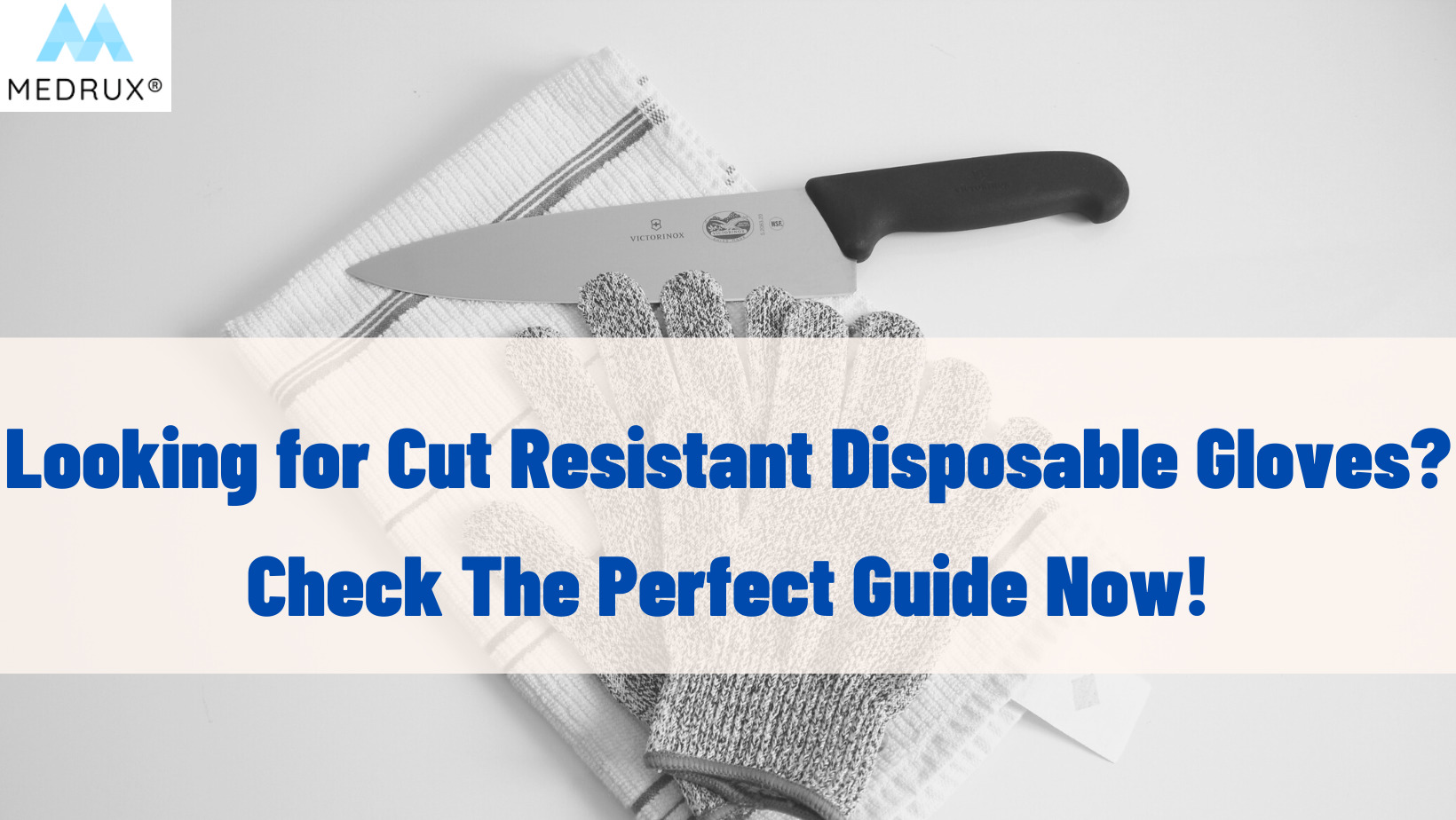There’s one thing in common between dentists, tattooists, and veterinarians: Needles!
Needlestick injuries may not be a common concern among many industries.
We get accidental pricks from needles and pins—just simple, instant pain that disappears with a drop of blood or none—and we carry on as if nothing happened.
However, it can be a severe issue if those needles are covered with blood or bodily fluids.
With such an issue, every day must find a way to protect themselves against this risk.
Therefore, needle-proof gloves started to find their way into the disposable glove world.
What is the difference between needle-proof gloves and puncture-proof gloves? Do they protect against needles? What are their testing methods?
Today, we’re going to answer all of these questions.
Additionally, we will go through the benefits, features, and uses of needle-proof gloves and how important they are in various industries.
Finally, we will help you choose the best needle-proof gloves.
Let’s begin
What are needle-proof gloves?
Needle-proof gloves are specifically designed to prevent injuries from punctures and accidental pricks from hypodermic needles; therefore, they can also be called “Hypodermic needle-resistant gloves.”
So, what are hypodermic needles?
Hypodermic needles are skinny, hollow tubes with sharp tips used in medical applications, whether attached to a syringe or IV line.
They’re used by doctors, nurses, dentists, lab technicians, and even patients, such as people with diabetes and asthma.
What’s more, they are used by substance addicts.
Needle-proof gloves are also known as needlestick-resistant gloves or anti-syringe gloves.
Why?
Because they reduce the number of needlestick injuries, which can be a source of bloodborne pathogen transmission.
In addition, they protect you from cuts with sharp, narrow objects such as syringes, IV needles, thin metal wires, and shards of glass.
Now let’s see what they are made of and their types.
Types of needle-proof gloves
Needle-proof gloves can be made from a variety of materials.
One thing to know before we know them is that no material can protect against all puncture or needlestick hazards.
In other words, no material is needle-proof.
Why?
Because the hazards can vary from job to job, different materials provide different resistant properties, offering various needle protection ranges.
Let’s look at the different types of needle-proof gloves.
-
Disposable types
They are made with rubber, such as butyl, nitrile, neoprene, and other plastics.
The most common type of disposable needle-proof gloves is nitrile.
Why?
Because it has high needle resistance and puncture, tear, and abrasion resistance.
Furthermore, it’s highly flexible and comfortable, fitting the hand like a second skin.
Therefore, it’s ideal when high dexterity, precise hand movement, and comfort are needed.
One study showed that the puncture resistance of nitrile gloves is significantly higher than that of latex gloves. (1)
In addition to its outstanding performance in protecting against bloodborne pathogens, it offers excellent resistance against a wide range of chemicals.
That’s why it’s ideal because the medical field is the riskiest for needles.
Whether in surgical rooms, hospitals, dental clinics, laboratories, or chemistry labs.
-
Reusable needle-proof gloves
They are made with metal mesh or fibers woven into the cloth. This includes:
-
Leather needle-proof gloves
These are made of natural or synthetic leather and are a popular choice for puncture-resistant gloves in the automotive industry; however, they don’t offer protection against hypodermic needles.
-
Knitted needle-proof gloves
These gloves are made with high-performance yarns and fabrics such as super fabric, spandex, Kevlar, or steel mesh.
Steel or metal mesh is excellent for good and blunt puncture resistance, but it is less durable than other types because it deteriorates over time and becomes less protective.
They’re not the most comfortable gloves you can wear and are expensive.
Woven Kevlar is the most popular choice for needle-proof gloves because it offers excellent needle, puncture, and cut resistance.
They combine high levels of needle protection, skill, and comfort.
Knitted needle-proof gloves are usually coated with rubber such as latex, nitrile, polyurethane, neoprene, etc., at the fingers, palms, back of the hand, or a combination of both for added grip and extra protection.
Bottom line:
Needle-proof gloves can be disposable or reusable.
They can be made of various materials.
Nitrile is the most used for disposable ones, while Woven Kevlar is for reusable ones.
Nevertheless, no material is needle-proof.
This brings us to the question: Are needle-proof gloves the same as puncture-resistant gloves?
Let’s find out.
Puncture-resistant gloves vs. needle-proof gloves.
A common misconception is that puncture-resistant gloves are the same as needle-proof gloves, which are invalid.
Even though glove manufacturers may use the two terms interchangeably, they are not the same.
Unlike puncture-resistant gloves, only needlestick-resistant gloves can protect against very thin sharps like hypodermic needles.
To understand this difference, let’s learn more about the testing for both.
Puncture-resistant gloves are tested according to the ANSI/ISEA 105-2016 Puncture Score or EN388 standard.
Both are designed to test the gloves against mechanical risks such as abrasion, cut, and tear resistance.
The puncture resistance test measures how much pressure is needed to penetrate the glove’s material.
In both methods, the test is done with a 1 mm steel stylus or probe almost as wide as a pencil tip.
The probe is pushed against the glove palm at 100 mm/minute speed at a right angle.
The main difference is that ANSI levels are scaled from 0–5, while the EN388 scale is 0–4, like the table below.
|
Level |
1 | 2 | 3 | 4 | 5 |
|
ANSI/ISEA |
10-19 N | 20-59 N | 60-99 N | 100-149 N |
150+ N |
| EN 388 | 20-59 N | 60-99 N | 100-149 N | 150+ N |
– |
What about the needle-proof test?
Let’s find out.
Certifications and standards for needle-proof gloves
As we mentioned before, puncture-resistant gloves don’t offer needle resistance.
Even though standard puncture and needle-proof gloves appear similar, they are tested differently.
To illustrate, we need to understand more about hypodermic needle thickness.
Needles usually range from 7 gauge (the largest or the thickest) to 33 gauge (the smallest or the thinnest).
The most common needle for drawing blood is the 21-gauge, while the 16-17 is used for blood donation, and the 19, 23, and 25 gauges are used in diabetes needles and substance addiction.
So, what’s the problem here? Why can’t we use the puncture test?
The puncture test and EN388 don’t include tests for hypodermic needles.
They use a blunt 1 mm steel needle or probe.
Meanwhile, in the hypodermic needle, for example, a 28-gauge is one-third of such a diameter, with a sharp tip 0.09 mm thick.
Furthermore, the tip in the test moves slowly, which is nothing compared to the fraction of time the hypodermic needle can prick you.
So, puncture-resistant gloves cannot stand a chance against them.
Looking at the puncture resistance score (ANSI or EN388) will not give you the proper idea of how much these gloves can protect you against needlestick injury.
They merely offer you the ability to face static spikes, thick splinters or wire, and edges of steel or similar mate.
Due to the importance of protection against these injuries, there has to be a certain standard to rely on when handling needles.
Therefore, for the thinner hypodermic needle, the American National Standard Institute (ANSI) created an ASTM F2878-10 test for needle-proof gloves.
ASTM F2878-10
In 2010, a new standard test method, ASTM F2778-10, was introduced for ‘Protective Clothing Material Resistance to Hypodermic Needle Puncture.”
Then, in 2016, the American ANSI/ISEA 105 Standard was updated to include ASTM F2878-10.
And it’s now the internationally recognized testing method specifically for needle-resistant gloves.
So, how does it work?
The test uses a 21-gauge, 25-gauge, or 28-gauge needle to measure the force needed to penetrate the glove fabric.
The 25-gauge needle is the accepted standard, although smaller gauge numbers (more comprehensive hands) can sometimes be used for better performance results.
Additionally, the needle travels at 500 mm/min, which is five times the speed of the regular puncture test.
A minimum of 12 samples are used to report the classification level.
0 is the lowest rating for gloves that can withstand under 2 newtons, while the highest rating is 5 for gloves with at least 10 newtons of resistance, as shown in the table below.
|
Level |
Force (Newton) | Applications |
|
0 |
< 2 N | Not needle-resistant |
|
1 |
≥ 2 N |
Light Duty |
|
2 |
≥ 4 N |
Light/Medium Duty |
|
3 |
≥ 6 N |
Medium Duty |
| 4 | ≥ 8 N |
Medium/Heavy Duty |
| 5 | ≥ 10 N |
Heavy Duty |
Usually, the highest level of resistance to the needle is only used when the hazards are unknown, and the highest level of protection is needed, like in level A PPE.
To avoid bulkiness and hand fatigue, most jobs employ gloves in the mid-level range.
What about ASTM F1342-05?
Manufacturers sometimes use the Modified ASTM F1342-05 for puncture tests; however, the test isn’t made explicitly for gloves.
It’s more of a standard test method for protective clothing material resistance to puncture for elastomeric materials, textiles, and coated materials.
It uses a 0.1-mm point tip needle unsuitable for hypodermic needle-resistant testing.
The ANSI puncture scores and EN388 are better used to test gloves against larger objects with risks, such as broken glass and wood splinters; they’re best for cut- and tear-resistant gloves.
Whereas the ASTM F2878-10 test method is the best to test against delicate, sharp objects such as medical needles, it’s now the international method to test these gloves.
Now let’s see what industries could benefit from needle-proof gloves.
Needle-proof gloves in the healthcare industry
The healthcare industry is full of numerous hazards, including needlestick-related injuries.
Doctors, surgeons, dentists, nurses, caregivers, workers in cleaning and laundry in healthcare facilities, and people working in research and development handle needles more frequently than other occupations.
In addition to needles, they handle things like scalpels, broken glass, suture needles, and other sharp tools.
Sometimes, when working quickly or carelessly, they can get bumped and pricked by a needle or other sharp objects.
Furthermore, needle sticks and sharp injuries can happen when:
- Drawing blood or administering drugs subcutaneously or intravenously
- Handle needles by taking them apart or recapping them after use.
- Disposing of needles attached to tubes
- Adjust the hand for the patient.
- Use needles or glass tools to transfer blood or bodily fluids between containers.
- Disposing of the hand properly
Needlestick is a severe health hazard.
Why?
Even though the stick of the needle itself can be nothing more than a nuisance, a hand can be contaminated with severe bloodborne pathogens such as the immunodeficiency virus (HIV), hepatitis B (HBV), and hepatitis C (HCV).
Moreover, the risk of infections from needle stick injuries (NSIs) ranges from 0.2 to 0.5% for HIV, 3–10% for HCV, and 40% for HBV. (2)
According to the Organization for Safety and Health Administration (OSHA), 5.6 million workers in the healthcare industry and related jobs are at risk of exposure to bloodborne pathogens. (3)
What’s more, the US Centers for Disease Control and Prevention (CDC) estimate 385,000 sharps injuries annually among hospital-based healthcare personnel (>1,000 damages per day). (4)
Injuries are costly in terms of illness but also life-altering and devastating.
Did you know that a single case of severe infection by bloodborne pathogens can add up to $1 million or more in expenses for testing, lost work time, and disability payments?
Furthermore, even when there’s no infection, the cost to an organization is a minimum of $5,000 for initial evaluation and ongoing treatment. (5)
Moreover, the emotional burden of fear, constant monitoring, and wondering if you will get a disease can sometimes be unbearable.
That’s why following infection control measures and wearing needle-proof gloves are highly important.
It will protect you against these injuries and dangers, help you feel safe while doing your job, and help you avoid anxiety and depression over the fear of getting a severe disease.
Furthermore, using the double-gloving technique can decrease the risk of being injured.
So imagine wearing two needle-proof gloves!
In conclusion,
Healthcare is one of the biggest industries with a high risk of needlestick injuries.
Therefore, the use of needle-proof gloves is essential for healthcare workers.
However, it’s not just the healthcare workers.
Did you know that law enforcement can also use needle-proof gloves?
Let’s find out more.
Why does law enforcement use needle-proof gloves?
People forget that police officers are among the first responders to drug overdose calls and emergencies.
In addition, those working with prisoners have to handle potential inmates who could be using drugs.
According to the National Institutes of Health (NIH), nearly 92,000 people died in 2020 from a drug-related overdose. (6)
During an overdose response, pat-down searches of a suspect and searches of a suspect’s property, vehicle, or incident site can bring them into contact with the needles used by the victims and abusers.
I bear in mind that many injection drug users have bloodborne pathogens because of shared needles and unsafe, non-hygienic practices.
As a result, first responders and police officers are at risk of needlestick injuries and the transmission of these infectious diseases.
Additionally, the needles could still be contaminated with many highly toxic substances, such as fentanyl and its analogs.
Therefore, it’s recommended for law enforcement to protect themselves by using PPE such as fentanyl gloves and needle-proof gloves. (7)
Some studies suggest that using needle-proof gloves reduces the chances of needlestick injuries for police officers. (8)
To sum it up,
Law enforcement officers and first responders are in danger of injuries due to the nature of their jobs.
Therefore, needle-proof gloves can be of great help in reducing this risk.
But other professions can use needle-proof gloves as well.
Let’s dig more.
Needle-proof gloves for other occupations
Needle-proof gloves are used in industrial settings, waste management, and agricultural and farming operations.
Additionally, tattoo artists, veterinary professionals, and sanitation workers use these gloves.
Let’s find out more.
-
Sanitation workers and waste management.
Sanitation workers, janitors, and people working in the recycling and waste management are at risk of needle stick injuries.
They are among the most common injuries among people who sort through trash to find recyclable items.
Why?
Because over 7.5 billion needles and syringes are used outside the healthcare system. (9)
People with diabetes, HIV, multiple sclerosis, or other conditions use them.
While the disposal of contaminated needles in the healthcare system is regulated and needles and syringes—for the most part—go to the right places without introducing other environmental hazards that add to the burden of PPE pollution, this is not the case in different settings.
The disposal outside the health care system isn’t regulated, and the needle can end up anywhere, from the proper landfills to the sides of streets.
This puts sanitation workers and waste collectors in danger as housekeepers and janitors in public places, hotels, airports, and restaurants.
Using needle-proof gloves keeps many people in the waste management and cleaning industries safe.
Even though people working in industrial settings may not be at as much risk of needle injuries as healthcare workers, needle-proof gloves can be helpful to protect them against cuts and punctures from handling thin and sharp tools.
Needle-proof gloves suit automotive, construction, glass handling, and metal stamping industries.
-
Tattoo artists
It seems apparent that tattoo artists need needle-proof gloves; their profession is based on needle use.
Tattooists and their clients risk infection if they do not take the proper precautions, including wearing gloves.
Needle-proof tattoo gloves are essential to prevent needlestick injuries, protect against punctures, keep the place clean, and prevent cross-contamination.
It also aids in keeping harsh chemicals and dyes used in the process from hurting the tattooist’s skin.
-
Vet professionals
Veterinary is the other face of the healthcare industry; instead of looking out for human health, they care about the animals’ health.
This means that the risks of needlesticks are nearly identical when dealing with animals.
Animal blood or bodily fluids can also be a source of contamination and diseases.
In addition to handling needles, professionals are at risk of hand injuries and cuts when treating animals with claws and sharp teeth.
That’s why vet gloves are essential to the PPE required to protect them.
And, of course, needle-proof gloves.
When handling contaminated sensitive equipment or tools, veterans wear needle-proof gloves.
Furthermore, they wear them when handling needles and administering IV injections to animals.
-
Gardening and agricultural applications
You must have experienced cuts, blood, and sharp pain due to being injured while pruning your roses or pulling weeds from your garden.
You must have looked up “rose-pruning gloves” or “weed-pulling gloves.”
Well, you can add needle-proof gloves to the list.
Needle-proof gloves are also used in gardening, agricultural, and farming applications, as they can protect your hands from tears and cuts while working with sharp tools.
The bottom line:
Needle-proof gloves aren’t only used in healthcare settings; they can have many other applications.
Among the famous industries that use them are waste management and gardening.
Additionally, they are used by veterinarians and tattooists.
So, how do you choose the best needle-proof gloves?
Let’s find out.
How to choose the best needle-proof gloves?
Risk assessment is the most crucial aspect to consider when selecting any type or level of PPE.
Why?
To understand the risk of needlestick injury or puncture risk in your workplace, which may necessitate the use of needle-proof gloves, cut-resistant gloves, or puncture-resistant gloves,
Nevertheless, a few tips exist when buying your next pair of needle-proof gloves.
-
Certified ASTM- F2878
Ensure your needle-proof gloves are not just punctured- or cut-resistant but actually “needle-resistant” and that their test is under ASTM F2878.
Most gloves don’t address this test because many fail to achieve good results.
Any glove that claims to be “needle resistant” or “needle proof” will be tested according to ASTM-F2878 and will even brag about it.
So, if you find a glove that’s tested accordingly with the 25-gauge needle, it’s more effective than most gloves that are not.
Although you likely won’t see this rating anywhere on the gloves, you can find it on spec sheets, additional tagging or packaging, online product listing pages, or by contacting the manufacturer directly.
-
Needle-proof Protection zones
Protection zones are the different areas on your gloves specifically designed to be needle-proof.
It’s important to know which zone of your gloves is needle-resistant.
Why?
Because each zone is used for different tasks and risks of injury, using one that can offer different protection zones is excellent.
Accordingly, it becomes easier for you to select gloves for the right task.
The palm, back of the hand, fingertips, and finger sidewalls can all be used individually or in combination as protection zones.
- Palm is the most compromised part of your hand and prone to needlestick injuries, so you’ll want the most protection here.
- Back-of-hand protection: Depending on the task, you’ll want to protect the back of your hand.
- Fingertips: are often one of the first parts that could come into contact with a needle.
- Finger sidewalls: can be vulnerable in a glove when needlestick hazards are present.
- A blend of protection and dexterity.
If you need needle-proof gloves, you might need your hands to move freely and precisely to do accurate tasks.
That’s why looking for needle-proof gloves that combine protection and skill without hindering your hands or making you feel bulky is essential.
Most high-level needlestick-resistant gloves are bulky.
It’s known that the thicker the gloves, the less movement and touch sensitivity you feel.
As a result, most people prefer to use middle ranges for protection and comfort.
Additionally, you can consider the results of the dexterity tests, such as the EN420 Pin Test and the ASTM 2010 or the ASTM 4032 Circular Bending Test.
-
Additional Features
Most needle-proof gloves contribute to higher cut resistance than usual gloves.
Make sure that your gloves will protect you against all expected risks.
In addition to this, you should also consider the following:
- Durability: how long your gloves will last.
- Quality: select needle-proof gloves with high-quality materials and high standards during manufacturing.
- Size: Choosing the correct size is essential because you cannot benefit from the gloves if they don’t fit you well.
- Price: How much are you willing to spend on your hand protection? It’s always a good idea to buy gloves that fit your budget without problems.
- Brand: It’s essential to know which brands you’re getting because the brand’s reputation and how much they care about their customers’ needs are vital.
Conclusion:
So, understanding the risks you face is the first step to choosing which type of needle-proof gloves you need, whether it’s the material or the protective zone they offer.
Furthermore, your needle-proof gloves should offer comfort, skill, and protection.
With other considerations like size, price, quality, and brand, you will find the best pair of needle-proof gloves.
We hope you now understand everything about this type of gloves.
Send us a message if you still have questions.







